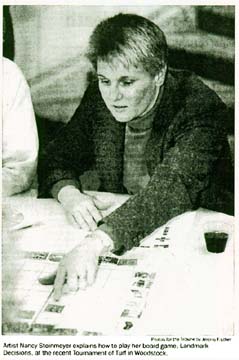| Each work
consists of a landscape covered by a mesh screen that
superimposes a painting of the same site at another time.
The artwork and the game will remain on display in the
gallery through February 25th. "In the game, you decide
what you want to do with land just like owners do,"
said Steinmeyer, who described the county as a sandbox
that must be shared by people supporting conservation and
those backing development.
The tournament was part
of "Full Moon Theatre," an environmental forum
sponsored each month by the Defenders. Steinmeyer is a
member of the grassroots group.
"The paintings
give me a sense of loss," said Ray Beth, 53, a
McHenry County native whose family immigrated from Europe
to Woodstock about 150 years ago. "The game reflects
the same thing: what is being taken away from the
county."
Landmark Decisions is
played by two or more people on a board that has a map of
undeveloped land on the Kishwaukee River watershed in
McHenry County divided into 36 squares or tracts.
Contestants get 30
tiles representing conservation with pictures of corn,
fish and deer, and 18 tiles depicting development,
bearing pipelines, factories, and housing. Players spin a
wheel with numbers corresponding to tracts on the board,
then decide whether to build or conserve on that tract.
The aim is to get five
identical conservation tiles on adjacent tracts. Players
can block each other or help each other.
"Cooperation
helped in the game the way it does in saving the
environment," tournament winner B.J. Jones, 63, of
Woodstock said.
Many players at the
tournament were reluctant to use development tiles to
block other players because they destroy wetlands,
farmland and forest, but Steinmeyer said there "is a
bigger lesson to be learned" when these tiles are
played.
"It can be so much
fun to get a little goofy, take on a role you
wouldn’t normally and try to kill everything,"
said Becki Clayborn, a Defenders member. "It shows
the different viewpoints of life."
"It’s a fun,
simple way to teach people that each land-use decision
effects the environment," said Meg Bradshaw, another
Defenders member.
Steinmeyer spent four
months researching the game, work that she said has
changed her.
"I’m more
diligent," she said. "I pull litter out of the
ditch and recycle cans and bottles."
The long term goal is
to market the game using different facts for different
areas. For now, the aim is to share it through
educational programs.
Steinmeyer quickly
admits the game is an oversimplification of complex
environmental issues, but it exaggerates extremes to make
it enjoyable for the children.
"The game is about
cause and effect," she said. "My hope is that
when the kids are 21, they’ll go ‘OK, if I do
this, something else might happen.’"
|
